7 Tips to Turn Your Apartment Balcony into a Cozy Oasis
We’re all spending a lot of time at home these days. In the summertime, it’s a godsend to have a backyard. But if you live in an apartment, you might have to make do with a balcony. That doesn’t mean you can’t have an outdoor haven for working from home or evening relaxation. Follow these tips to make the most of your tiny patio and turn it into the perfect outdoor retreat.
1. Start with the Floor
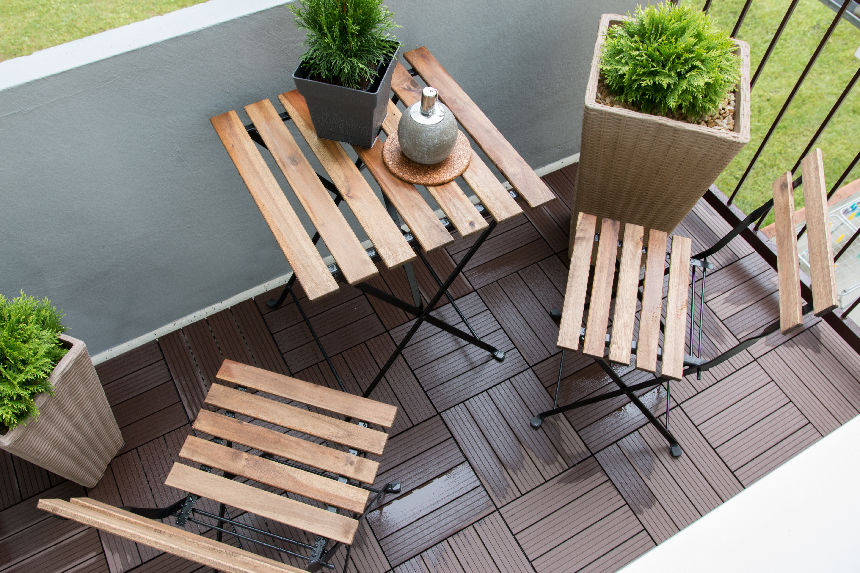
Sprucing up the drab concrete floor of your balcony can do a lot to change the space. Visit your local international grocery store to find outdoor rugs for a reasonable price. Alternatively, you can buy deck tiles that snap together, or go an oddball route with something like AstroTurf. If you’re a fan of colorful patterns — and if you’re ready for a project — consider painting your concrete balcony floor using a stencil to give the illusion of tiles. (Make sure to check with your landlord before making any permanent changes.)
2. Get Creative to Save Space
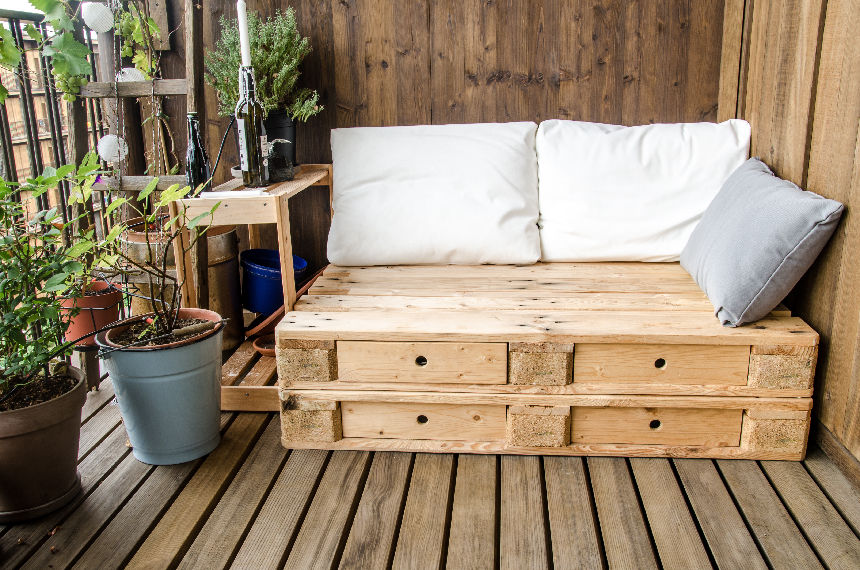
When it comes to balconies, going wild with outdoor furniture can cost you precious space. You can avoid this pitfall with a rail bar. These bar tops attach to your balcony railing. You can purchase one online, or you could try constructing it yourself. If you decide to DIY, make sure it’s as solid as a rock and has a sturdy backing so you don’t send mojitos flying to the street below.
Consider furniture that doubles as storage, like an outdoor bench that opens up like a chest. Of course, this one is DIYable as well. These are perfect for keeping your gardening paraphernalia out of the way.
3. Add Greenery
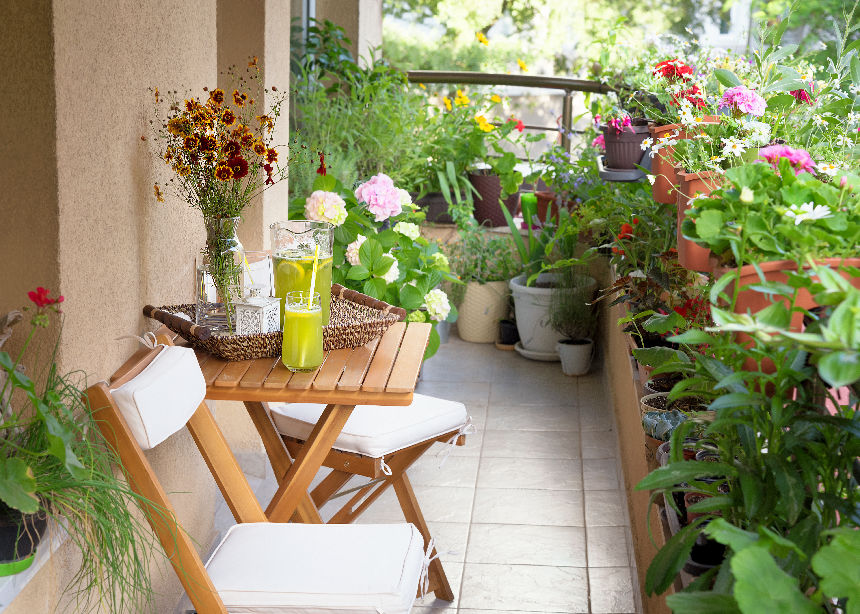
Some type of flora is necessary to create the ideal balcony retreat. If you’re new to gardening, start by assessing the kind of sunlight your balcony gets. Full sun (six or more hours of direct sun) will allow for some different options than partial sun or full shade. Don’t limit yourself to leafy decorative tropicals and succulents, either. Grow vegetables and herbs — like bell peppers or Thai basil — to get the most out of your outside space.
4. Light It Up
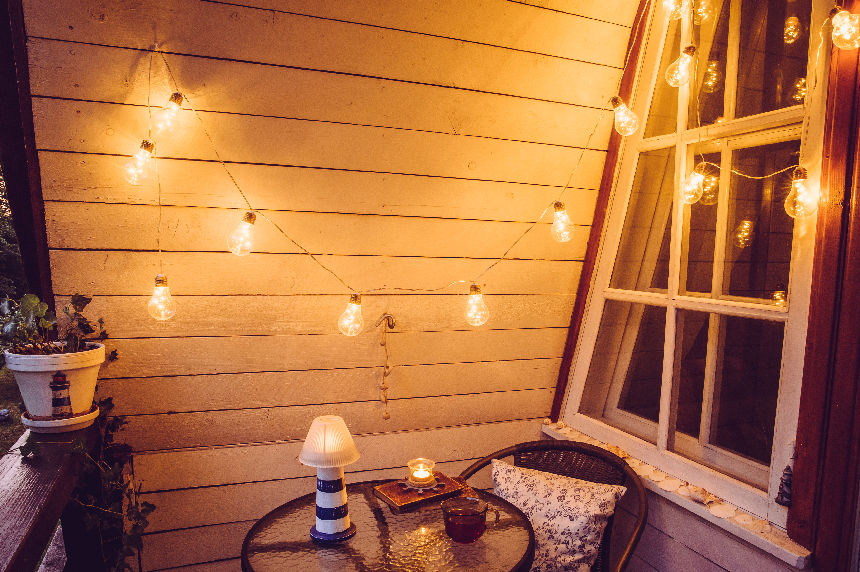
The classic lighting choice for a balcony is a trusty package of string lights. But you don’t have to settle for this old standby. There are plenty of other options for outdoor lighting— some of them solar — to make your balcony seem like an extension of your house. Go for a nice bronze reading lamp or a modern globe floor LED light.
5. Keep the Mosquitoes Away
A lot of us would spend so much more time outside if it didn’t come with the threat of being eaten alive by mosquitoes. Those summertime bloodsuckers are pesky, but you don’t have to suffer for an evening in the moonlight. Some solutions that come highly recommended are the Thermacell Patio Shield and, for a natural option, the Mintronella repellant candle.
6. Suspend Your Seating
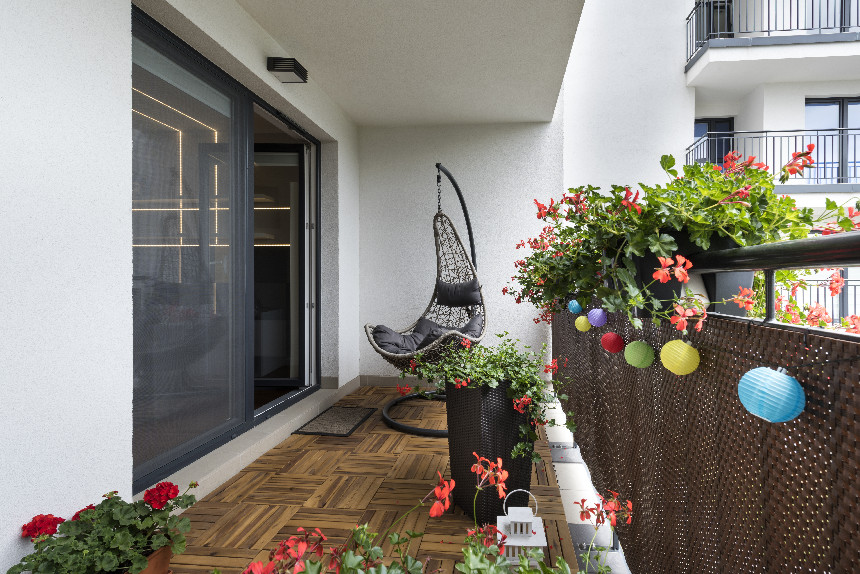
For a fun, swinging seating option, install a wicker egg chair that hangs from a steel chain. (Check out the best way to safely mount a swing chair.) Comfortable and charming, hanging seating also adds style to your space. For outdoor dozing and reading, a hammock is a very affordable option to turn your balcony into a cozy spot.
7. Make It Private and Shady
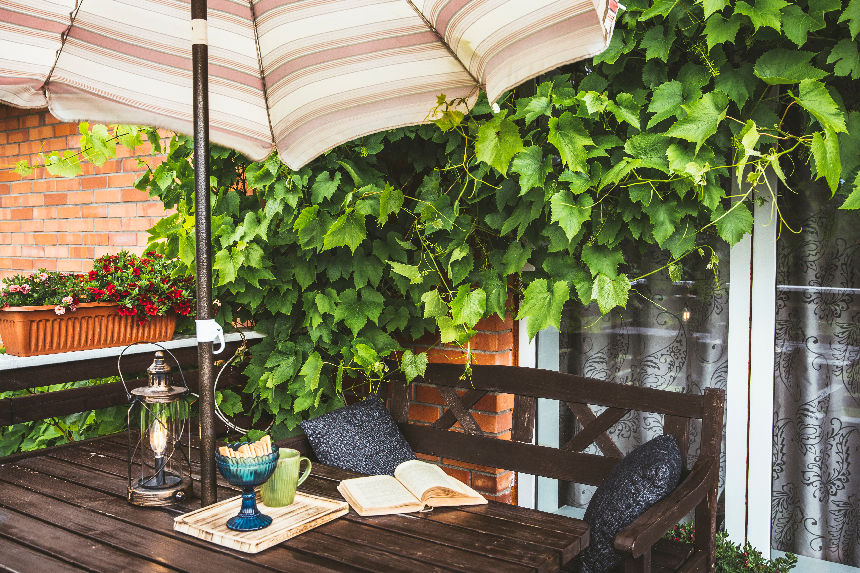
If you plant right, some strategic greenery can close off your balcony to neighbors and onlookers. Alternatively, installing some outdoor curtains will give you an adjustable screen for shade and privacy. There are many other options, like bamboo panels or inexpensive lattice. For a quick and sleek shade solution, consider a shade sail.
Featured image: Shutterstock
How to Keep an Orchid Alive
“The worst instructions ever perpetrated on orchid growers is the suggestion to water with ice cubes,” says Ron McHatton, the Chief Science and Education Officer at the American Orchid Society. “These are tropical plants. Do you want your feet in ice water?”
Of course, not all orchids are tropical, but the ones McHatton is recommending for you — a novice orchid owner — are. They are called Phalaenopsis, and they are an “easy” houseplant to grow.
That might be disheartening to read if you’ve ever killed one, but McHatton says you only need some better advice to keep a moth orchid thriving in your home. Step one: save the ice for your martinis.
Orchids are one of the most diverse families of flowering plants in the world. Their unique blooms beguile expert growers and casual plant lovers alike. The Phalaenopsis family boasts more than 60 species, though you’ll have to do some hunting to find more than a handful that are commonly cultivated.
The most important factor in orchid care might be the place you choose to purchase your plant. Those colorful blooms greeting you at the entrance of your favorite big-box department store might be enticing, but McHatton says you’re better off going with a local orchid dealer or nursery. A knowledgeable grower can answer questions about your plant and give you practical advice for growing it in whatever conditions you face. It’s unlikely that the cashier at Target will harbor the same expertise.
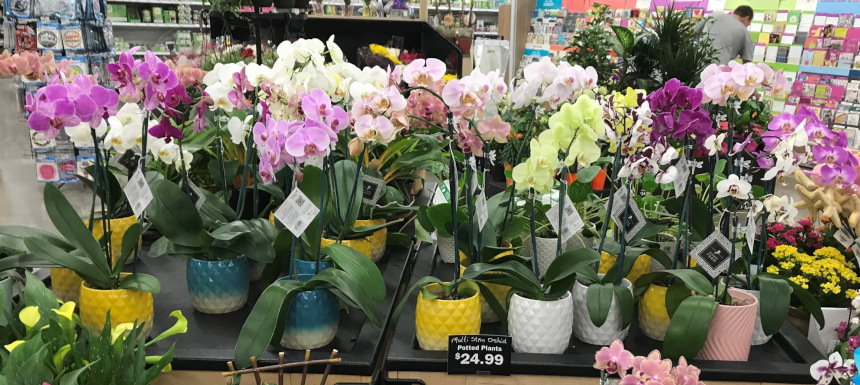
Furthermore, McHatton says, many orchids sold at big-box stores are doomed from the start: “I’ve seen lots of plants in stores where the die has already been cast. The plants already have a root-rotting fungus before they’re even purchased.” The reason for this, sometimes, is that the plants are sold growing in sphagnum moss. While this is an acceptable substrate for orchids, it holds water longer than others. This gives the plants more moisture for the long periods of time they could be sitting on a shelf, and that could cause problems. Before buying an orchid, inspect the roots to make sure they look healthy and firm.
And once you get the thing home? McHatton says, “don’t stick them in a shady corner and overwater them.” Put your orchid in a bright spot by a window, and allow it to dry out before each watering.
It isn’t exactly as straightforward as it sounds, though. There isn’t a one-size-fits-all watering regimen for Phalaenopsis orchids, because it depends largely on the kind of pot and substrate you’re using, not to mention the humidity of the room. Sphagnum moss dries out the slowest, then coconut chips, bark, and clay pellets. For the vessel, a plastic pot will take longer to dry out, then terra cotta, and a slotted clay pot or a basket will dry the fastest. The combination that you use should match your watering habits as well as the environment you can offer.
An orchid might be okay in a slotted pot with coconut chips in a moderately bright, humid bathroom, but the same plant will have a hard time sitting over a heating vent in winter. McHatton refers to a person’s ability to pick up on a plant’s needs as a “plant sense,” and he says it works the same way with many houseplants. If you can keep it alive long enough to see it thrive while you’re treating it well, you’ll know what it wants.
Repotting plants is an inevitable stage of houseplant care, but McHatton says newbie growers need not repot their orchid right away. It damages the roots and stresses the plant during an already stressful transition from one place to another. When you do repot, McHatton says to rinse out coconut chips and bark first to remove any remaining salts from the manufacturer.
Watering an orchid plant is just as straightforward as watering most other houseplants. Run water over the roots for 30 seconds or so to flush out salts from your tap water, and leave it to mostly dry out before repeating. The problem with using ice cubes is that the salts from trickling water compound on the plant’s roots and substrate without being fully rinsed away.
Generally, orchids prefer an environment with higher humidity. Spritzing them with a spray bottle is fine, but it won’t create any lasting humidity. If you feel your orchid is drying out a little too quickly, it might benefit from some nearby plant friends. Ferns and peace lilies surrounding the plant will keep the air around the orchid moist, particularly if you water them often. As a last resort, you can set the orchid pot in a tray of water that will moisten the pot and immediate air without wetting the roots.
Do you feel as though you’ve mastered Phalaenopsis orchids, and you want something a little more challenging? McHatton says the next steps are Lady’s Slippers and Cattleyas, two genuses that require slightly more light and stringent watering routines, but offer bloom shapes and sizes that differ from the Phalaenopsis genus. He warns against going wild if you’re struck with plant fever, though. “We get so enamored by the plant that we buy everything we see and then we try to figure out how to grow it,” McHatton says. “It’s much easier to try to grow the plants that are better suited to the conditions you can provide.”
Ron McHatton hosts a monthly webinar on orchid care on the American Orchid Society website.
Featured Image: Natalie Board on Shutterstock
House Detective: Finding History in Your Home
Like the 250-year-old house from Ipswich in the Smithsonian’s National Museum of American History, your home has a story to tell and a place in history. Whether you own your house, rent it, or live in an apartment, you and your family can become house detectives and discover the history of your home.
1. Start at home. The best source about your home is the building itself, and everyone in the family can join in this part of the investigation. Look at the separate parts of the building—roof, walls, chimneys, doors, windows, and foundation. Note what materials they are made of and how the different parts are joined to one another. Try to distinguish original materials from later additions.
Look at the style of the house, too, inside and out (and use the books listed on the back panel of this brochure to help identify building styles and materials). The style of a building is a clue to its age—but not proof. In some parts of the country, a building style stays popular longer than in others. Keep careful notes and take pictures. The clues you record will be useful later on in your investigation.
2. Go to the courthouse, or wherever deed records are kept in your community. Using deed records, you can create a chronological list of all of the owners of a piece of property. The list you compile will be the backbone of your home’s history.
Ask for the index to deeds by buyer. Start with the deed to the present owner. Note the seller’s name and the legal description of the property. Then use the index to find the seller’s deed to the same piece of property and note whom the seller bought it from. Work your way back through the deeds to the original owner, make a copy of each deed, and keep track of the page and volume numbers. A sharp increase in the value of the property could mean a building was added to it.
3. Look at other public records, especially if you find gaps in the deed records. Sometimes property passes from one owner to another through a mortgage or a will, and these documents will probably be wherever you found the deeds (or at least nearby).
Mortgage records often contain detailed descriptions of buildings. Wills and other probate records may list one or more of the previous owners, and you can examine the records filed under their names to see if there are any mentions of the property. Local tax records may reveal the dates of additions and improvements to property by a change in its valuation, and maps of property made by surveyors can show a tool shed or a well that no longer exists. Be sure to make photocopies of all the records that you think will be helpful.
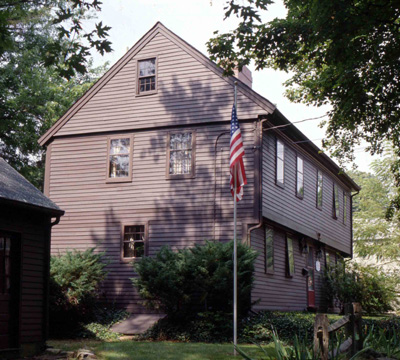
Photo courtesy of the National Museum of American History.
City directories often list people’s occupations as well as addresses and can help to establish the dates that a person lived at a particular address. A librarian can also direct you to federal and state census records. They can contain vast amounts of information about households.
A good library or Internet project for children is to create a timeline of American history starting with the approximate construction date of your building. When the kids have completed a simple timeline for the nation, the family can work together to combine it with the timeline for your home and look for connections. You might find a
link between a big event in American history and a small event in your home’s history.
5. Read a map. Your librarian can guide you to city and county maps that may show your building with the owner’s or resident’s name written beside it. Such maps often show the location of old roads and other landmarks that may have disappeared. Insurance maps, especially those produced by the Sanborn Map Co., contain a wealth of information about individual structures, including the materials from which they were built.
6. Look at a picture. Your local library or historical society may have old photographs of your building, or there may be some in your neighbors’ attics. Postcards can be helpful, too. Many towns are represented in nineteenth-century lithographs called “bird’s-eye views,” which sometimes provide an accurate picture of every residence in town. Don’t forget to take a few photographs of your home for the project, or better yet, have children in the family take the photographs or draw pictures of your building.
7. Talk to people. Try to track down former residents or their children. They may be able to help you date changes or tell you stories about their lives in your home. Neighbors can be helpful, too, if they have lived in the neighborhood a long time. The whole family can put together a list of questions to ask the neighbors about your home and neighborhood. While you are talking to them, ask if they have any family pictures that might show your building in the background.
8. Put it all together. When you have finished your research, you will have a stack of written notes, photocopies of documents and maps, and photographs. These are like the pieces of a puzzle. Use them to create a timeline of your home’s past and to write a narrative history. Enlist everyone in the family to help create a scrapbook that weaves together the narrative history, photocopies, drawings, and photographs, and then make enough copies to give your family and friends. Be sure to place a copy in your local historical society or library, so that your home will have a place in history.
9. Is the building you’re living in brand new? Then start your own history of your home. Using some of the steps outlined above, find out what was there before your building was built and why the neighborhood changed. Then take photos of your home and write about your experiences living in it. You will be making history for your family and community.
Further reading. These books to may help in your research:
Barbara J. Howe. Houses and Homes: Exploring Their History.
Nashville, Tennessee: American Association
for State and Local History, 1987.Howard Hugh. How Old Is This House?
New York: Noonday Press, 1989.Sally Light. House Histories: A Guide
to Tracing the Genealogy of Your Home.
Spencertown, New York: Golden Hill Press, 1997.Virginia and Lee McAlester. A Field Guide to American Houses.
New York: Alfred A. Knopf, 1997.
Visit the “Within These Walls…” website at
http://americanhistory.si.edu/house.
No Place Like It
Home. The word resonates right to the center of who we are. It connects us to family, memories, our communities, even to ourselves.
For some, home is primarily a nest that nurtures, a refuge that protects, a delight that allows us to exercise the playful side of our natures. For others, it’s a sturdy structure of brick and mortar that anchors us—or a shell of aluminum that sets us free.
Even more, as architect Claire Cooper Marcus points out in her book, the aptly titled House as a Mirror of Self, our homes reflect our priorities, our values, and our histories—they are all on display through the places where we choose to live. On the following pages, you’ll meet some amazing people whose homes do just that. We think you’ll find their stories both familiar and surprising.
The manner in which we design, adapt, and furnish our homes says a great deal about who we are, too, as individuals, as families, and as a society. New homes are getting smaller—the era of the oversized “McMansion” is over (for now). At the same time, households are expanding to accommodate two, three, even four generations under one roof. Revolutionary products and services are allowing older homeowners to live long lives, safely, happily, and independently in the same house; meanwhile, wireless and integrated “smart” technologies let others redefine their notions of home entertainment, convenience, and comfort. As you’ll see, these and other housing trends in America are more than just the bloodless facts and statistics of a multibillion dollar industry—they are the very measure of our hopes and dreams.
As twilight settles over Boston’s historic Beacon Hill neighborhood, Victorian gaslights glow against the aged brick row houses that have stood here for close to 200 years.
Inside one of the elegant homes here, Susan McWhinney-Morse sits in the living room of her home and counts her blessings. “I have everything,” says the active septuagenarian. “A garden in back. A deck off the kitchen. A beautiful living room with high ceilings, exquisite plasterwork, and two wood-burning fireplaces. My four children all grew up in this house, and they loved it. They can’t imagine not coming home.”
The house has been through a lot of changes since Susan moved here with her first husband some 40 years ago. After that marriage ended in divorce, Susan took in boarders to support herself. Her family occupied three floors, but with other floors in the house, there was plenty of room for paying guests.
“The house has been so flexible,” Susan says. “When I married David Morse 15 years ago, the kids were all grown up, and we really didn’t need all this room. So we downsized within our own house. We turned the house into three separate apartments. We have the main floor, four bedrooms, and David and I each have our own study.”
To make sure that she and David are able to stay in their home as they age, Susan and her neighbors formed a community organization that offers services to Beacon Hill residents: dog walking, house painting, garden weeding, grocery shopping, rides to the airport,
even someone to help rearrange the furniture.
“The idea was to be on Beacon Hill forever,” says Susan. “The people here have a great sense of community, of neighborhood, and of caring for who we are and what happens here. We started with 11 people who were wild about the idea, and it’s just grown.”
As the Home Roams
Stella rocks. A 200-square-foot Airstream Excella, Stella measures 29 feet at her longest point. She’s covered in polished aluminum, and her interior boasts wood floors, custom cabinetry, an antique metal backsplash in the kitchen, a stained-glass window, sheer window treatments throughout, and a couch that flips into a bed. In short, all the comforts of home, for only $15,900, delivered to the Maryland driveway of Ramona Creel and her husband, Matt Boorstein.
“Stella’s hip and cool and awesome and I love her,” says Ramona. So much so, in fact, that she and Matt decided to sell their house, reinvent their careers, and take to the open road. Permanently.
“The house thing just wasn’t working for us,” says Ramona. And they were miserable in Maryland, spending nights and weekends fixing up the house and days working to pay for it. Plus, all that work cut into their travel time.
“Some people are perfectly content staying at home, living in the same town their whole lives, not really caring if they see the world,” Ramona writes from somewhere near Atlanta. Or San Diego. Or maybe it was Louisiana. “Not me! I inherited busy feet from my father. Nothing excited him more than jumping in the car and taking off to someplace he had never been. I’m the same way.”
Matt is, too. Ramona’s husband was a military brat who grew up wandering the country. Initially he worked in interior design while Ramona, who has a degree in social work, found homes for displaced families in Florida. Eventually, she started her own business as a professional organizer of homes and offices, while Matt started work developing her business’ Web site. To earn money and remain mobile, Matt morphed into a full-time Web designer. Now, Ramona coaches clients via the Web, with occasional meetings when Stella pulls into an RV park, and Mark runs his business online. Wherever they can hook up to a server, an electrical outlet, and a water faucet, they’re in business. It’s a life that suits them well. “It just feels like the right path,” says the woman with busy feet. “We didn’t want the house. We don’t need the big screen TV. We want the experiences.”
Where are they off to next?
Ramona laughs. “Florida. We follow the good weather.”
Under One Roof
Standing proudly in front of the chicken coop on his grand-mother’s three-acre homestead in Starksboro, Vermont, 8-year-old Christopher Gravelle carefully holds out two eggs so fresh they’re still warm from the hen. He carefully explains to visitors the hows and whys of raising chickens as he walks toward their outdoor pen. His sister, Courtney, a 6-year-old blonde elf in a lavender parka and sparkly shoes, bounces along beside him. “Know what?” she asks, pointing across the yard. “That’s my bike!”
Along with their hens, bikes, and cats, Christopher and Courtney have lived here in the gray clapboard house all their lives. Their grandparents, Bob and Sue Baker, bought the property 28 years ago to raise their daughters—Lori, now 26, who works at a kitchen-and-bath shop in Burlington, 27-year-old Jessica, and 31-year-old Shelly, a stay-at-home mom to Christopher, Courtney, and 9-year-old Thomas.
“The house was old but the price was right,” says Sue. “And we liked the neighborhood.”
Situated between a two-lane rural highway and the wooded foothills of the Green Mountains, the house, with its fenced-in front yard, sits on one side of State Route 116 with neighboring homes spaced well apart. A cornfield is across the road.
“I love my property,” says Sue. “I have two apple trees, a big garden, a bird feeder, we’re bordered by Lewis Creek, and the kids can fish.”
The big draw for her was the yard. “When we first moved here, we had a maple tree by the fence that shaded the yard, and there was one that shaded the house,” Sue remembers. “Those girls could play in that yard all day. They had their swing out there, and it was nice. During the summer, you could sit in the living room and feel the breeze blowing through.”
As time went by, the kids grew up, Shelley got married and moved away, and Sue picked up part-time work at a local supermarket, a golf course, and a neighboring elementary school. But then Sue’s husband developed cancer, and nine years ago he died. Five months after that, Sue had a heart attack and quadruple bypass surgery.
Concerned, Shelley and her husband, Jason, moved back home with baby Thomas to give Sue a hand. Christopher and Courtney were born over the next couple of years, and things seemed to be getting back on track. Then Jason died of a heart attack, and Shelley was suddenly a single mother.
Things have been tough ever since. Sue was able to work part time as a cafeteria worker at the local Robinson Elementary School until her job was outsourced in budget cuts last spring. Lori has a job; Jessica and Shelley don’t. The family heated the house last winter with a woodstove and two kerosene heaters, but one of the heaters broke, and Sue didn’t have the money to fix it. That’s a concern in an area with below-zero temperatures in January.
But Sue shrugs it off. When something breaks down, generally the girls figure out how to fix it. “You learn this stuff as you go along,” says Sue. “We had a major toilet clog last week, so the girls became plumbers. They went and got plumbers’ snakes, took the toilet off, pushed the snakes through, had the septic tank pumped, and got it fixed.
“When you got family, you do what you’ve got do,” she adds. “This place has been a refuge for everybody.”
Big Little House
Benjamin Speed and his wife Sarina grew up on Maine’s rocky coast, exploring lighthouses and cracking lobster at the Bucks Harbor market. Then they headed for college in Washington State, and, like so many children, vowed never to return home.
After they graduated, Sarina went to work as a jewelry designer; Ben worked as a videographer. Both realized just how deep their roots were embedded in Maine’s sandy soil, how much they missed their folks, and how strongly they felt that the children they would have should be raised close enough to know their grandparents.
The two returned to Maine and rented an apartment. Ben got a job teaching film production with a local school and picked up a few extra bucks videotaping weddings, while Sarina continued with her design work.
But paying all that money for rent really bugged the practical Sarina. So the couple, in their mid-20s at the time and with a baby on the way, decided to build a house. And not just any house, but one that reflected their values—something large enough to meet their needs, but small enough to respect the environment and leave a reasonable footprint on the planet. A footprint, in fact, that measured 18 feet by 18 feet.
“People don’t need as much space as they think,” says Sarina, who grew up in an even smaller house. “We can’t have huge groups of people over, but for three people it’s more than enough.”
Aside from leaving a smaller environmental footprint, the house also makes sense in the current economy. “I wanted to build something so that if our jobs didn’t work out, we could still afford our house,” Sarina says.
Borrowing as little as possible from the bank, and with help from friends and family, the Speeds built the two-bedroom house themselves. “We did the basic framing, roofing, shingling, and insulation,” Sarina says. “The stuff that would take us too long to learn we farmed out.” As a result, the house—including its foundation and the road leading to the house—cost just $55,000.
With son Noah now 4½, and baby Larkin newly arrived, Sarina and Ben are planning to build on a third bedroom. “But the house will never be more than 800 square feet,” says Sarina, firmly. “And we’ll have the mortgage paid off by the time the kids go to college.”
Smartest Homes Ever
As history has proven, new technologies—from electric lights and appliances to radios and televisions—inevitably make their way into the home. When they do, they make life easier, more efficient, and more fun.
Tony Tessaro would agree. Standing on Mandalay Beach in California, the 60-year-old retired Wall Street trader is like a kid with a new toy. Only that toy is his whole home. And it’s a smart home. “I can control everything from my TV clicker,” says Tony. “Say I’m watching TV and you ring the doorbell. There’s a camera in the bell, so a photo of you pops up on the screen.”
Tony loves that the house “knows” who he is. “We have a two-car garage,” he says. “One side’s me, one side’s my wife, Mary.” When the garage door opens and she drives in, the house senses it’s her, then closes the garage door, lights up a path to her bedroom, and turns on her favorite music.
Trends in home technology are changing the way we come home and what goes on in the home, from lights and music to control of heat pumps and central air for energy efficiency, says Laura Hubbard, a spokesperson for the Consumer Electronics Association.
Companies such as Russound, for instance, offer customizable equipment that plays music in different areas throughout your home from a single device, controlling the system with iPod-like keypads. Some systems read smart tags embedded in a phone or a keychain and respond according to the preferences of the tag’s owner.
While advanced systems can cost thousands and require extensive remodeling, the do-it-yourself route offers affordable off-the-shelf systems. Take HomePlug, for example: This concept allows TVs and computers to communicate via the home’s pre-existing electrical wiring. Home automation is just the beginning, Hubbard says. In coming years, with the advent of the “smart grid”—a more efficient system of delivering electricity to your home—new home appliances will turn themselves on when it’s the most efficient time of day to do chores.